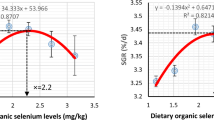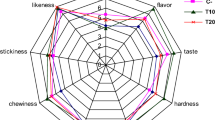Abstract
An 8-week feeding trial was conducted to evaluate the effects of three dietary methionine (Met) sources [dl-Met, coated-Met, and a methionine hydroxy analogue calcium salt (MHA-Ca)] for Chinese soft-shelled turtle (Pelodiscus sinensis). Triplicate groups of juvenile turtles (initial weight 3.48 ± 0.03 g) were fed twice per day at 3% of body weight with positive control diet (T1, 46% protein and 46% fish meal, FM), negative control diet (T2, 43% protein and 23% FM), or three other test diets supplemented with either 0.2% coated-Met (T3), 0.125% MHA-Ca (T4), or 0.1% dl-Met (T5) to the T2 basal formulation, respectively. The feeding trial was conducted in 15 350-L plastic containers with three replicates per dietary treatment. The results showed that the highest and lowest percentage weight gain (1023.5 ± 18.2 versus 882.1 ± 14.5%) and feed efficiency (87.2 ± 0.94 versus 81.4 ± 0.4%) were observed in turtles fed the T1 and T2 diet (P < 0.05), respectively. Significant improvement in weight gain was observed in turtles fed diets with Met supplementation, irrespective of source, compared with turtles fed the T2 diet. It was observed that dietary MHA-Ca had similar efficacy compared with dl-Met in terms of growth performance and feed utilization efficiency of the turtles (P > 0.05). Protein utilization efficiency was significantly higher in turtles fed T4 or T5 diet compared to the T2 diet. Whole body protein content (17.0 to 17.4% on a wet weight basis) in turtles fed with Met-added diets was comparable to those of turtles fed the T1 diet which were significantly higher compared to T2-fed turtles. Antioxidant defense system enzymes, superoxide dismutase, and glutathione peroxidase showed the highest activity, 658.8 ± 17.9 U/mL and 642.8 ± 17.5 μmol/L, respectively, in the serum of turtle fed the MHA-Ca supplemented diet and was significantly higher compared to turtles fed the T2 or T3 diet. The present results showed that P. sinensis are able to effectively use added MHA-Ca and dl-Met in low protein and low FM diets to enhance growth, feed utilization efficiency, nitrogen retention, and antioxidant defense system enzyme activities.
Similar content being viewed by others
References
Association of Official Analytical Chemists (AOAC) (2003) Official methods of analysis of the Association of Official Analytical Chemists (15th edn). Association of Official Analytical Chemists Inc, Arlington
Carter CG, Sajjadi M (2011) Low fishmeal diets for Atlantic salmon, Salmo salar L., using soy protein concentrate treated with graded levels of phytase. Aquacult Int 19:431–444
Cheng ZJ, Hardy RW, Blair M (2003) Effects of supplementing methionine hydroxy analogue in soybean meal and distiller’s dried grain-based diets on the performance and nutrient retention of rainbow trout [Oncorhynchus mykiss (Walbaum)]. Aquac Res 34:1303–1310
China Fishery Statistical Yearbook (2017) Ministry of Agriculture and Fisheries Bureau of China. China Agriculture Press, Beijing (in Chinese)
Day OJ, Plascencia-Gonzalez HG (2000) Soybean protein concentrate as a protein source for turbot, Scophthalmus maximus L. Aquac Nutr 6:221–228
Dibner JJ (2003) Review of the metabolism of 2-hydroxy-4-(methylthio) butanoic acid. World’s Poultry Sci J 59:99–110
Espe M, Anderson SM, Holen E, Rønnestad I, Veiseth-Kent E, Zerrahn JE, Aksnes A (2014) Methionine deficiency does not increase polyamine turnover through depletion of hepatic S-adenosylmethionine in juvenile Atlantic salmon. Br J Nutr 112:1274–1285
Fagbenro OA, Davies SJ (2004) Use of high percentages of soy protein concentrate as fish meal substitute in practical diets for African catfish, Clarias gariepinus (Burchell 1822). J Appl Aquac 16:113–124
Feng L, Xiao WW, Liu Y, Jiang J, Hu K, Jiang WD, Li SH, Zhou XQ (2011) Methionine hydroxy analogue prevents oxidative damage and improves antioxidant status of intestine and hepatopancreas for juvenile Jian carp (Cyprinus carpio var. Jian). Aquac Nutr 17:595–604
Forster IP, Dominy WG (2006) Efficacy of three methionine sources in diets for Pacific white shrimp, Litopenaeus vannamei. J World Aquac Soc 37:474–480
Gatlin DM III, Barrows FT, Brown P, Dabrowski K, Gaylord TG, Hardy RW, Herman E, Hu GS, Krogdahl Å, Nelson R, Overturf K, Rust M, Sealey W, Skonberg D, Souza EJ, Stone D, Wilson R, Wurtele E (2007) Expanding the utilization of sustainable plant products in aquafeeds: a review. Aquac Res 38:551–579
Goff JB, Gatlin DM III (2004) Evaluation of different sulfur amino acid compounds in the diet of red drum, Sciaenops ocellatus, and sparing value of cystine for methionine. Aquaculture 241:465–477
Hardy RW (2010) Utilization of plant proteins in fish diets: effects of global demand and supplies of fishmeal. Aquac Res 41:770–776
Huang CH, Lin WY (2002) Estimation of optimal dietary methionine requirement for softshell turtle, Pelodiscus sinensis. Aquaculture 207:281–287
Keembiyehetty CN, Gatlin DM III (1995) Evaluation of different sulfur compounds in the diet of juvenile sunshine bass (Morone chrysops ♀ × M. saxatilis ♂). Comp Biochem Physiol 112A:155–159
Kelly M, Grisdale-Helland B, Helland SJ, Gatlin DM III (2006) Refined understanding of sulphur amino acid nutrition in hybrid striped bass, Morone chrysops ♀ × M. saxatilis ♂. Aquac Res 37:1546–1555
Kim KI, Kayes TB, Amundson CH (1992) Requirements for sulfur amino acids and utilization of D-methionine by rainbow trout (Oncorhynchus mykiss). Aquaculture 101:95–103
Kokou F, Rigos G, Kentouri M, Alexis M (2016) Effects of DL-methionine-supplemented dietary soy protein concentrate on growth performance and intestinal enzyme activity of gilthead sea bream (Sparus aurata L.) Aquacult Int 24:257–271
Lemme A, Hoehler D, Brennan JJ, Mannion PF (2002) Relative effectiveness of methionine hydroxy analog compared to DL-methionine in broiler chickens. Poul Sci 81:838–845
Liang XP, Zhou QC, Li M, Yang Q, Elmada ZC (2015) Effects of crystalline methionine and 2-hydroxy-4-(methylthio) butanoic acid on growth performance and protein metabolism of juvenile giant freshwater prawn, Macrobrachium rosenbergii. J Ningbo Univ ( NSEE ) 28:1–7 (In Chinese)
Lin SM, Luo L (2008) Effects of different levels of soybean meal inclusion in replacement for fish meal on growth, digestive enzymes and transaminase activities in practical diets for juvenile tilapia, Oreochromis niloticus × O. aureus. Anim Feed Sci Tech 168:80–87
Lloyd LE, McDonald BE, Crampton EW (1978) Metabolic processes of the body and the roles of energy-yielding nutrients. Fundamentals of nutrition (2nd edn) (ed. ry G.W. Salisbury). W.H. Freeman and Company, San Francisco, pp 103–133
Ma R, Hou HP, Mai KS, Bharadwaj AS, Cao H, Ji FJ, Zhang WB (2013) Comparative study on the effects of L-methionine or 2-hydroxy-4-(methylthio) butanoic acid as dietary methionine source on growth performance and anti-oxidative responses of turbot (Psetta maxima). Aquaculture 412–413:136–143
Mambrini M, Roem AJ, Cravèdi JP, Lallès JP, Kaushik SJ (1999) Effects of replacing fish meal with soy protein concentrate and of DL-methionine supplementation in high-energy, extruded diets on the growth and nutrient utilization of rainbow trout, Oncorhynchus mykiss. J Anim Sci 77:2990–2999
Ng WK, Hung SSO, Herold MA (1996) Poor utilization of dietary amino acids by white sturgeon. Fish Physiol Biochem 15:131–142
Powell CD, Chowdhury MAK, Bureau DP (2017) Assessing the bioavailability of L-methionine and a methionine hydroxy analogue (MHA-Ca) compared to DL-methionine in rainbow trout (Oncorhynchus mykiss). Aquac Res 48:332–346
Robinson EH, Allen OW Jr, Poe WE, Wilson RP (1978) Utilization of dietary sulfur compounds by fingerling channel catfish: L-methionine, DL-methionine, methionine hydroxy analogue, taurine and inorganic sulfate. J Nutr 108:1932–1936
Sveier H, Raae AJ, Lied E (2000) Growth and protein turnover in Atlantic salmon (Salmo salar L.); the effect of dietary protein level and protein particle size. Aquaculture 185:101–120
Takagi S, Shimeno S, Hosokawa H, Ukawa M (2001) Effect of lysine and methionine supplementation to a soy protein concentrate diet for red sea bream Pagrus major. Fish Sci 67:1088–1096
Trejo-Escamilla I, Galaviz MA, Flores-Ibarra M, Álvarez-González CA, López LM (2017) Replacement of fishmeal by soya protein concentrate in the diets of Totoaba macdonaldi (Gilbert, 1890) juveniles: effect on the growth performance, in vitro digestibility, digestive enzymes and the haematological and biochemistry parameters. Aquac Res 48:4038–4057
Xiao WW, Feng L, Liu Y, Jiang J, Hu K, Jiang WD, Li SH, Zhou XQ (2011) Effects of dietary methionine hydroxyl analogue supplement on growth, protein deposition and intestinal enzymes activities of juvenile Jian carp (Cyprinus carpio var. Jian). Aquac Nutr 17:408–417
Zhao EM, Adler K (1993) Herpetology of China. Society for the Study of Amphibians and Reptiles, Ohio, pp 175–176
Zhao JX, Li XQ, Leng XJ, Peng S, Hu J, Zhao XX (2017) Comparative study on the utilization of different methionine sources by channel catfish, Ictalurus punctatus (Rafinesque, 1818). Aquac Res 48:3618–3630
Zhou F, Wang YQ, Ding XY, Ng WK, He F, Xue HL (2016) Partial replacement of fish meal by soy protein concentrates in diets for a new Japanese strain of juvenile soft-shelled turtle, Pelodiscus sinensis. Aquac Res 47:875–886
Acknowledgements
We thank Tongxiang Wangcheng Aquaculture Co., Ltd. and Zhejiang Xinxin Feed Co., Ltd. for supplying the experimental soft-shelled turtles and feed ingredients, respectively. We also thank Wan-Hua Zhou, Lin-Lin Pu, Yin Hua, and Lian Ye for their assistance in caring for the animals and sampling.
Funding
The study was funded by the public welfare project from the Science Technology Department of Zhejiang Province, China (2015C32029), Science Foundation of Zhejiang Province (LQ14C190001), and the Natural Science Foundation of China (31501605).
Author information
Authors and Affiliations
Corresponding author
Rights and permissions
About this article
Cite this article
Zhou, F., Wang, YQ., Bei, YJ. et al. Assessing the efficacy of three methionine sources in low protein and low fish meal diet for Chinese soft-shelled turtle, Pelodiscus sinensis . Aquacult Int 26, 15–26 (2018). https://doi.org/10.1007/s10499-017-0193-3
Received:
Accepted:
Published:
Issue Date:
DOI: https://doi.org/10.1007/s10499-017-0193-3




